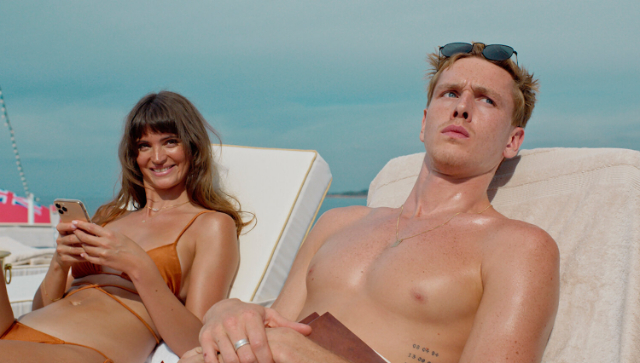In a scene from Ruben Ostlund’s Triangle of Sadness, a modelling couple bickers over who paid for lunch inside an elevator. “I want us to be equals,” the man says, angrily. The same people who quarrel about parity in this film, go to extreme lengths to look a certain class and grade. It’s this sinister dichotomy that Ostlund’s film seeks to uncover, in mischievous ways. The only problem is that for two quarters of a third, Triangle of Sadness, is a wonky, ferocious takedown of entitlement and its myriad discontents. For the last half, however, the film wants to philosophise existentialism and survival, philosophical ideas that somewhat moisten the savagery of money and elitism that it spends the majority of the film ripping apart. The Palme D’Or winning film follows a modelling couple Carl (Harris Dickinson) and Yaya (Charlbi Dean Kriek), who are invited aboard a luxury cruise, as part of a influencer programme. The reward, quite comically, is the trip itself and none of the perks or luxuries that translate to a possession of sorts. The challenge for both, thus is to will an experience into existence that rivals the thrill of something they can own. It’s a challenge that plays out constantly, to rapturously comic extents, whether its Carl’s naïve attempts to impress Yaya, or her subsequent denial of the allure, money and privilege stands for. While these internal battles play out, the cruise becomes the sight of a cultural catastrophe. Under stormy conditions, a disinterested captain - played incidentally by Woody Harrelson - and a handful of overindulgent middle-aged folk, _Triangle of Sadness_ quickly devolves to unleashing hell on its protagonists. Apart from Yaya and Carl, on board the ship there is Dimitry, played by a typically bullish Zlatko Buric. It’s not exactly inspired casting, but Buric is believably reprehensible as a rich oligarch swimming in ugly wealth; wealth that he consistently flaunts like a degenerate. It’s this predictability that makes the narrative unsurprising but wildly effective. The film, despite its simplicity, captivates without ever accessing the ambiguity of deep philosophical ideas. There is no subtle oscillation between messaging here. Just the plain rollout of physical and mental pain. The film, quite simply, punishes the rich, as a simple punch-up narrative that Ostlund interprets as an actual punch. Refuse mixes with food, commodes swell and luxury turns to nightmarish indulgence as the film tips the occasion, as opposed to the metaphorical table. Ostlund commandeers a simple premise to a neatly, unambiguous culmination after the first half. A voyage has gone awry and so has the conception of luxury, the many securities and privileges it affords you. Where the film goes off track is in its last half, where moored on an island, survivors of the cruise engage in a battle of pettiness as opposed to wits. It feels like an unnecessary epilogue, the kind of survivor cinema that would have fit the tapering end of another kind of film. Here it feels inconsequential, a stretched piece of elastic trying to earn comedic points by dolling out fairly obvious rhetoric. There is a touch of Ostlund’s subtle humour here, but none of it elevates the story. Also, despite a sectioned narrative, the film really loses tension and the claustrophobia of a tight, if luxurious boat, the moment it lands on a beach. The Triangle of Sadness is excellent while it is at sea. Ostlund manages to mine cringe and conflict from the most mundane of moments. A scene where the ship’s deputy captain delivers a motivational speech, feels terribly discomforting – illustrative of the lengths the service industry must go to indulge a handful of the rich. A scene where an old guest speaks to a pool attendant, is a masterclass in creating tension through a seemingly harmless conversation. It highlights the many ways, class distinctions play out in the subtlest of ways; ways that blind us to our own ability to demand and deny. Someone’s right to deny, evidently, is greater than the other. Ostlund has to his credit the kind of filmography that underlines the importance of our different senses. In his latest film, taste, smell, sight and sound, all play prominent roles as cultural idioms are instantly flipped to reveal sides that we are coached to never interrogate. All of this is done through fairly simple benchmarking, the kind of whispery grammar that doesn’t demand its actors to express as much as it forces them to embody. Therein lies the key to almost all of his films, where most characters, react to the world around them rather than bend it to their pre-scripted will. The problem with Triangle of Sadness, however, is that for once, Ostlund strains too hard say something, somewhat culling the impact of a film, that could have been more quite simply by being less. It’s riveting, funny and cathartic despite audaciously silly, nonetheless.
Manik Sharma writes on art and culture, cinema, books, and everything in between. Read all the Latest News , Trending News , Cricket News , Bollywood News , India News and Entertainment News here. Follow us on Facebook, Twitter and Instagram.


)
)
)
)
)
)
)
)
)



